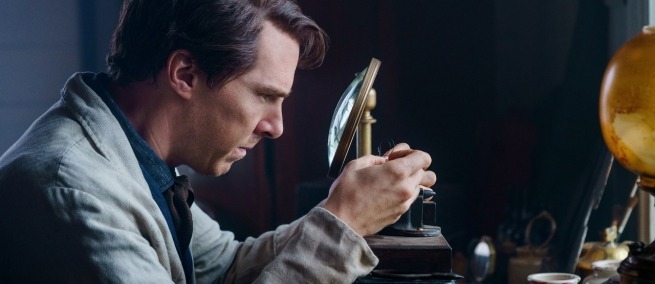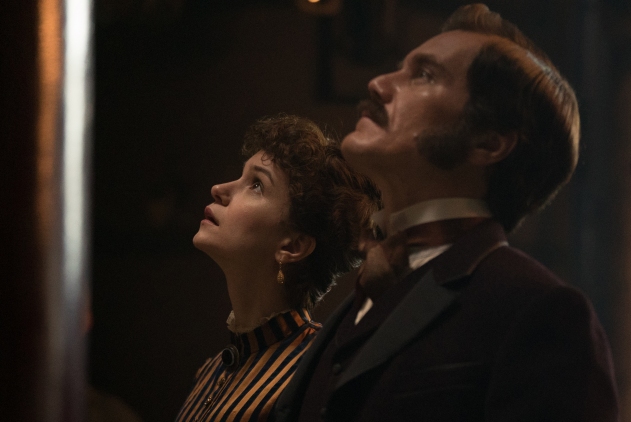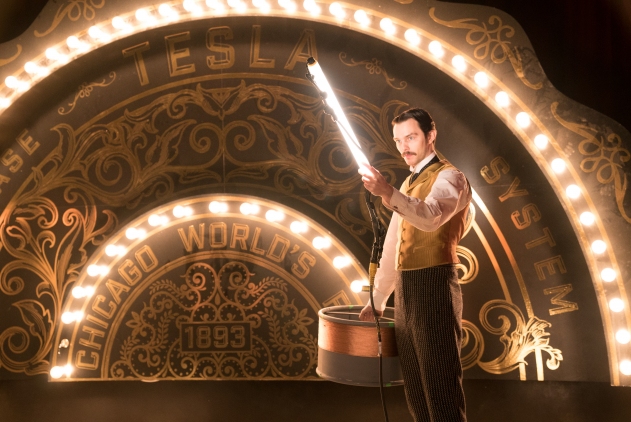
Starring Benedict Cumberbatch as inventor Thomas Edison, THE CURRENT WAR will be released in October, two years after its initial release date. The film was originally set to be distributed by the Weinstein Company after premiering at the 2017 Toronto International Film Festival, but was pulled after Weinstein’s sexual misconduct allegations and the Company’s bankruptcy. It will now be distributed by 101 Studios and will open in theaters on October 4.
In addition to Cumberbatch, THE CURRENT WAR stars Michael Shannon as George Westinghouse and Nicholas Hoult as Nikola Tesla. It is set during a thirteen-year period beginning in the early 1880s when Edison and Westinghouse were vying for the implementation of their opposing means of delivering electricity—direct and alternating current. The film is directed by Alfonso Gomez-Rejon (ME AND EARL AND THE DYING GIRL) and written by Michael Mitnick, who has previously received support from the Sloan Foundation as a playwright. We interviewed Mitnick in September of 2017, before the film’s Toronto premiere, and that interview is republished below.
Science & Film: How did you become interested in the “war of the currents”?
Michael Mitnick: Elements of this story were woven throughout my childhood. I grew up in Pittsburgh, Pennsylvania–Westinghouse’s name was everywhere. My father is a professor, so trips were usually education-oriented; we visited Edison’s laboratory, Niagara Falls, and battlefields. My first assignment in graduate school [Mitnick has an MFA from Yale Drama], was to write a monologue inspired by history. Immediately, I thought of Edison. That night I came across the 13-year period of his life called the “war of the currents” in which Edison and Westinghouse began an epic battle over whose current would power the world. I couldn’t believe that I had never heard of it. The first monologue I wrote was about Edison apologizing to a little boy for electrocuting his dog. The monologue blossomed into a full length musical. In drama school we mounted a full production for $250. In 2011, I wrote the screenplay version.
After all this time for the story to find its way to Alfonso Gomez-Rejon, the director, and to see the artistry he and Benedict and Michael have done–it floors me.

Katherine Waterston and Michael Shannon in THE CURRENT WAR
S&F: I’m curious if you found Edison to be a sympathetic character? In researching Nikola Tesla, I’ve come across stories about how difficult Edison was.
MM: He was his own invention. He was self-educated, self-made, and was the first worldwide celebrity who wasn’t in politics. Edison was driven by both a curiosity to see what was possible and a desire to put his name on it. He refused to fail, whether it be in the lab or in the papers. So when Westinghouse challenged Edison on his greatest legacy–electricity–the smear campaign started as did Edison’s secret work developing the first electric chair.
S&F: How does Tesla figure into your screenplay?
MM: We meet Tesla when he was sent from Edison’s Paris company to work in New Jersey alongside Edison himself. Most of the mythology of Edison screwing over Tesla is apocryphal. From the logs and memoirs I read, Edison paid Tesla a much larger salary than his other men. Tesla had his sights on building his own company, which failed largely due the crooked men who paid for it. Later, when Westinghouse couldn’t build a motor that worked with his Alternating Current, it was Tesla and his new polyphase motor that served as the key to Westinghouse and Tesla’s triumph over Edison. It’s funny–after Edison failed with electricity, his most profitable success was the storage battery intended for electric cars. Diesel won, but it would also make a lot of sense for Tesla, Inc. to be named after Edison. When you can charge the cars without plugging them in, that would be a good time to name them Tesla.
S&F: And maybe once they’re free for everybody too.
MM: And free for all, yes. Good call.

Nicholas Hoult in THE CURRENT WAR
S&F: What were the primary sources that you used for research?
MM: When I started writing THE CURRENT WAR it was just whatever I could dig up in the public domain. I wanted as much as possible to use real quotations and then mimic the men’s voices.
The incredible 40-year plus efforts of Paul Israel and Rutgers University to preserve Edison’s papers were invaluable. For a very brief period, Edison kept a diary that I pulled from. Frances Jehl, one of Edison’s assistants, wrote a fun three-volume book of his memories. Other sources were newspapers, the Library of Congress, and the New York Sun which had a lot of coverage of the electric chair.
Westinghouse was far trickier. He erased himself from history. There’s one public domain book and a few tributes that were where I had to get almost everything. Andrew Masich and Pittsburgh’s History Center have some of the wonderful items that managed to survive. What emerged from these bits is pieces was a glimpse of a man whose greatest motivation was what his company contributed. It feels almost silly to think he could be so selfless, but that’s largely who he was. Westinghouse gave his men homes with running water and heat, he puts hospitals next to his factories. He is the reason we have Saturdays off. Westinghouse thought he would get better work if his employees were more relaxed and could blow off steam playing an afternoon of baseball.
S&F: How did you decide how much scientific or technical information to include in the story?
MM: That was particularly difficult and changed day to day. It was essential to me I allow audiences understand what Edison and Westinghouse are trying to do without bringing in exposition or stopping what is most important–the drama.
But there was a lot to make clear to people who have had no physics: What is the difference between alternating and direct current? How does electricity work? What is a dynamo? What is a transformer? How does a motor work? It is a better story if you’re able to understand what Edison and Westinghouse are actually fighting over.
S&F: Benedict Cumberbatch has obviously played a genius inventor before, and I wonder to what extent that served as a touchstone for him getting into the character of Thomas Edison?
MM: I can’t speak to his process, but he didn’t mention Sherlock or Turing during shooting. I know he relied heavily on a lot of research about Edison. I imagine one of the things that was attractive to him about THE CURRENT WAR was that he is playing an American, and someone in a completely different era: the second Industrial Revolution–top hats and immigrants.
S&F: What happens next for the film after the Toronto International Film Festival?
MM: It opens theatrically Thanksgiving weekend. This story has been a large part of my life the last ten years; it’s both thrilling and intimidating to realize that it’s finally time for people to see it.
THE CURRENT WAR will open in theaters on October 4, 2019. The film stars Benedict Cumberbatch, Michael Shannon, Nicholas Hoult, Katherine Waterston, Tom Holland, Matthew Macfadyen, and Tuppence Middleton. Martin Scorcese is the executive producer.
TOPICS